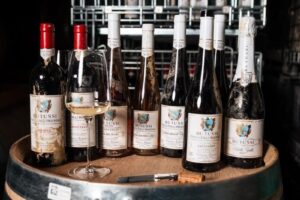
Florence as Paris, London and Venice, not only for beauty and richness of its cultural heritage, but thanks to “urban vineyard” at Piazzale Michelangelo: “Vigna Michelangelo” celebrates one year of life with view over the “cradle of the Renaissance”, a real collection of historical vineyards of Tuscany, 700 shoots among Sangiovese, Pugnitello, Foglia Tonda, and Canaiolo, planted by Donne Fittipaldi, owners of the historical company of Bolgheri. A city vineyard which is part of Urban Vineyards Association, headed by Italian Nicola Purrello, custodian of urban vineyard in Catania, at the basis of Etna, and which embraces 10 countries in 4 continents for a total of 21 urban vineyards, in addition to the mentioned cities, from Turin to Vienna, from Salonicco to Palermo, from Milan to Melbourne, from Lisbon to Lyons, from Los Angeles to Bergamo, from Brasilia to Barcelona, and Avignon. And, where, any vine plant on the sweet hill dominating the city carries also a plate dedicated to wine journalists, such as the founders of WineNews Alessandro Regoli and Irene Chiari, and not only. All together, they represent a wine project conjugating landscape protection, urban sustainability, and valorization of Tuscan native varieties, which is the real “mission” of Vigna Michelangelo.
The initiative is headed by the company of Bolgheri Donne Fittipaldi, founded and headed by Maria Fittipaldi Menarini, who, together with daughters Carlotta, Giulia, Serena, and Valentina, decided to requalify the family ground with a wine project with a strong symbolic and environmental value. “This vineyard represents our roots, the history of our home, and of our childhood – explains Maria Fittipaldi Menarini – but, it is also a concrete signal towards a high quality and aware urban agriculture”.
Started in 2021, and presented to the public in 2022, the project foresees the realization of a sapling vine - form of upbringing, among the most ancient and qualitative – on hill ground exposes to North-East. A plant with controlled density, with a “quincunx” disposition (five-point chess set) thought to optimize the occupation of soil, and favor the drainage on relevant inclinations. Varieties were selected not only for wine quality, but also for their historical and cultural coherence with the territory. “We chose traditional varieties, also little widespread to give again value to biodiversity, and to historical viticulture of Tuscany”m involved technicians explain.
From an agronomic point of view, the project was followed by agronomist Stefano Bartolomei, while enological consultancy is entrusted to Emiliano Falsini (already collaborator in Tuscany of group Tommasi Family Estates with Podere Casisano, in Montalcino). “We created a vineyard characterized by a strong landscape integration – underlines Bartolomei – which maintains the characteristics of the territory untouched. The sapling allows a manual management of the plant, and favors the quality of grapes”. Falsini anticipates the identity of future wine: “it will be a product which conjugates tradition and contemporaneity, basing on freshness, elegance, and territorial recognizability”. The vines planted in 2024 will begin to produce grape, which is adapt to vinification starting from 2027, with a yield estimated at about 700 bottles for the first vintage. The aim is to destine this production to philanthropic initiatives: bottles will be sold through international auctions, with earnings destined to projects of social impact.
Because “wine is not the final aim, but the means - concludes Maria Fittipaldi Menarini - what we want to valorize is the bond between man, earth, and urban environment. A project which intends to give value again to green space in the city, and promote a model of integrated agricultural sustainability”. Narrating how it has always characterized wine system in Tuscany.
Copyright © 2000/2025
Contatti: info@winenews.it
Seguici anche su Twitter: @WineNewsIt
Seguici anche su Facebook: @winenewsit
Questo articolo è tratto dall'archivio di WineNews - Tutti i diritti riservati - Copyright © 2000/2025